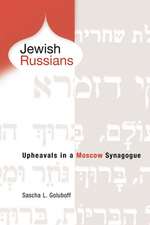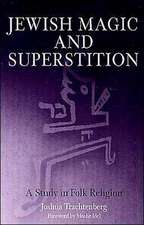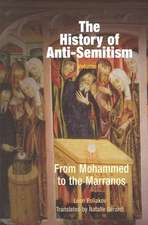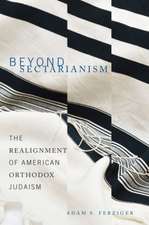Exclusion and Hierarchy – Orthodoxy, Nonobservance, and the Emergence of Modern Jewish Identity: Jewish Culture and Contexts
Autor Adam S. Ferzigeren Limba Engleză Hardback – 8 iun 2005
Din seria Jewish Culture and Contexts
-
 Preț: 448.21 lei
Preț: 448.21 lei -
 Preț: 198.22 lei
Preț: 198.22 lei -
 Preț: 285.64 lei
Preț: 285.64 lei -
 Preț: 192.05 lei
Preț: 192.05 lei -
 Preț: 433.78 lei
Preț: 433.78 lei -
 Preț: 237.53 lei
Preț: 237.53 lei - 11%
 Preț: 480.95 lei
Preț: 480.95 lei -
 Preț: 288.94 lei
Preț: 288.94 lei -
 Preț: 244.38 lei
Preț: 244.38 lei -
 Preț: 295.23 lei
Preț: 295.23 lei -
 Preț: 232.70 lei
Preț: 232.70 lei - 11%
 Preț: 449.87 lei
Preț: 449.87 lei -
 Preț: 337.06 lei
Preț: 337.06 lei - 23%
 Preț: 570.97 lei
Preț: 570.97 lei -
 Preț: 469.00 lei
Preț: 469.00 lei -
 Preț: 372.81 lei
Preț: 372.81 lei -
 Preț: 245.25 lei
Preț: 245.25 lei - 11%
 Preț: 570.69 lei
Preț: 570.69 lei - 11%
 Preț: 478.37 lei
Preț: 478.37 lei -
 Preț: 245.25 lei
Preț: 245.25 lei - 11%
 Preț: 440.19 lei
Preț: 440.19 lei -
 Preț: 467.05 lei
Preț: 467.05 lei - 11%
 Preț: 509.01 lei
Preț: 509.01 lei - 11%
 Preț: 443.59 lei
Preț: 443.59 lei - 11%
 Preț: 445.33 lei
Preț: 445.33 lei -
 Preț: 516.53 lei
Preț: 516.53 lei -
 Preț: 406.30 lei
Preț: 406.30 lei - 11%
 Preț: 503.73 lei
Preț: 503.73 lei - 11%
 Preț: 535.02 lei
Preț: 535.02 lei - 11%
 Preț: 470.68 lei
Preț: 470.68 lei - 11%
 Preț: 447.03 lei
Preț: 447.03 lei - 11%
 Preț: 477.51 lei
Preț: 477.51 lei - 11%
 Preț: 506.29 lei
Preț: 506.29 lei - 11%
 Preț: 502.86 lei
Preț: 502.86 lei -
 Preț: 435.69 lei
Preț: 435.69 lei -
 Preț: 436.67 lei
Preț: 436.67 lei - 11%
 Preț: 448.73 lei
Preț: 448.73 lei - 11%
 Preț: 444.13 lei
Preț: 444.13 lei -
 Preț: 417.84 lei
Preț: 417.84 lei - 11%
 Preț: 440.19 lei
Preț: 440.19 lei - 11%
 Preț: 505.43 lei
Preț: 505.43 lei - 11%
 Preț: 507.99 lei
Preț: 507.99 lei -
 Preț: 438.95 lei
Preț: 438.95 lei - 11%
 Preț: 469.80 lei
Preț: 469.80 lei - 11%
 Preț: 506.29 lei
Preț: 506.29 lei - 11%
 Preț: 447.90 lei
Preț: 447.90 lei - 11%
 Preț: 441.30 lei
Preț: 441.30 lei - 11%
 Preț: 473.52 lei
Preț: 473.52 lei - 11%
 Preț: 501.97 lei
Preț: 501.97 lei -
 Preț: 339.71 lei
Preț: 339.71 lei
Preț: 448.73 lei
Preț vechi: 504.19 lei
-11% Nou
85.86€ • 89.89$ • 71.05£
Carte tipărită la comandă
Livrare economică 05-19 aprilie
Specificații
ISBN-10: 0812238656
Pagini: 320
Dimensiuni: 152 x 229 x 15 mm
Greutate: 0.68 kg
Ediția:New.
Editura: MT – University of Pennsylvania Press
Seria Jewish Culture and Contexts
Locul publicării:United States
Cuprins
Preface
Introduction. The Emergence of Parallel Phenomena: Orthodox Judaism and the Modern Nonobservant Jew
PART I. TRADITION, EXCLUSION, INCLUSION, AND HIERARCHY
Introduction
1. A "Community of the Faithful": Hakham Zevi Hirsch Ashkenazi (1660-1718) and the Religious Pluralism of the Spanish-Portuguese Diaspora
2. The Forerunners of Orthodoxy
3. The Age of the Hatam Sofer: Early Nineteenth-Century Orthodoxy and the Emergence of Internal Boundaries
4. The Formulation of Hierarchical Judaism: Rabbi Jacob Ettlinger and the Nature of modern Jewish Identity
PART II. VARIATIONS OF HIERARCHICAL JUDAISM: GERMAN ORTHODOXY IN THE LATE NINETEENTH CENTURY
Introduction
5. The Hirschian Hierarchy: Communal Separation and the Nonobservant Jews
6. Bambergerian Unity and the Hierarchical Principle
7. The Conscious Hierarchy of Berlin Separatist Orthodoxy
Conclusion: The Hierarchical Model and Orthodox Centers Outside of Germany
Afterword
Appendix: Pre-Modern Rabbinic Sources Regarding Non-Observance
List of Abbreviations
Notes
Bibliography
Index
Acknowledgments


















